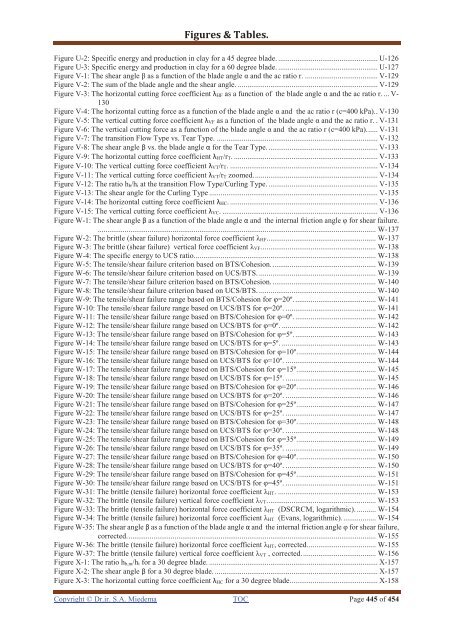The Delft Sand, Clay & Rock Cutting Model, 2019a
The Delft Sand, Clay & Rock Cutting Model, 2019a
The Delft Sand, Clay & Rock Cutting Model, 2019a
You also want an ePaper? Increase the reach of your titles
YUMPU automatically turns print PDFs into web optimized ePapers that Google loves.
Figures & Tables.<br />
Figure U-2: Specific energy and production in clay for a 45 degree blade. .................................................... U-126<br />
Figure U-3: Specific energy and production in clay for a 60 degree blade. .................................................... U-127<br />
Figure V-1: <strong>The</strong> shear angle β as a function of the blade angle α and the ac ratio r. ...................................... V-129<br />
Figure V-2: <strong>The</strong> sum of the blade angle and the shear angle. ......................................................................... V-129<br />
Figure V-3: <strong>The</strong> horizontal cutting force coefficient λ HF as a function of the blade angle α and the ac ratio r. ... V-<br />
130<br />
Figure V-4: <strong>The</strong> horizontal cutting force as a function of the blade angle α and the ac ratio r (c=400 kPa). . V-130<br />
Figure V-5: <strong>The</strong> vertical cutting force coefficient λ VF as a function of the blade angle α and the ac ratio r. . V-131<br />
Figure V-6: <strong>The</strong> vertical cutting force as a function of the blade angle α and the ac ratio r (c=400 kPa). ..... V-131<br />
Figure V-7: <strong>The</strong> transition Flow Type vs. Tear Type. .................................................................................... V-132<br />
Figure V-8: <strong>The</strong> shear angle β vs. the blade angle α for the Tear Type. ......................................................... V-133<br />
Figure V-9: <strong>The</strong> horizontal cutting force coefficient λ HT/r T. ........................................................................... V-133<br />
Figure V-10: <strong>The</strong> vertical cutting force coefficient λ VT/r T. ............................................................................. V-134<br />
Figure V-11: <strong>The</strong> vertical cutting force coefficient λ VT/r T zoomed. ................................................................ V-134<br />
Figure V-12: <strong>The</strong> ratio h b/h i at the transition Flow Type/Curling Type. ......................................................... V-135<br />
Figure V-13: <strong>The</strong> shear angle for the Curling Type ........................................................................................ V-135<br />
Figure V-14: <strong>The</strong> horizontal cutting force coefficient λ HC. ............................................................................. V-136<br />
Figure V-15: <strong>The</strong> vertical cutting force coefficient λ VC. ................................................................................. V-136<br />
Figure W-1: <strong>The</strong> shear angle β as a function of the blade angle α and the internal friction angle φ for shear failure.<br />
................................................................................................................................................. W-137<br />
Figure W-2: <strong>The</strong> brittle (shear failure) horizontal force coefficient λ HF. ........................................................ W-137<br />
Figure W-3: <strong>The</strong> brittle (shear failure) vertical force coefficient λ VF. ........................................................... W-138<br />
Figure W-4: <strong>The</strong> specific energy to UCS ratio. .............................................................................................. W-138<br />
Figure W-5: <strong>The</strong> tensile/shear failure criterion based on BTS/Cohesion. ...................................................... W-139<br />
Figure W-6: <strong>The</strong> tensile/shear failure criterion based on UCS/BTS. ............................................................. W-139<br />
Figure W-7: <strong>The</strong> tensile/shear failure criterion based on BTS/Cohesion. ...................................................... W-140<br />
Figure W-8: <strong>The</strong> tensile/shear failure criterion based on UCS/BTS. ............................................................. W-140<br />
Figure W-9: <strong>The</strong> tensile/shear failure range based on BTS/Cohesion for φ=20º. .......................................... W-141<br />
Figure W-10: <strong>The</strong> tensile/shear failure range based on UCS/BTS for φ=20º. ............................................... W-141<br />
Figure W-11: <strong>The</strong> tensile/shear failure range based on BTS/Cohesion for φ=0º. .......................................... W-142<br />
Figure W-12: <strong>The</strong> tensile/shear failure range based on UCS/BTS for φ=0º. ................................................. W-142<br />
Figure W-13: <strong>The</strong> tensile/shear failure range based on BTS/Cohesion for φ=5º. .......................................... W-143<br />
Figure W-14: <strong>The</strong> tensile/shear failure range based on UCS/BTS for φ=5º. ................................................. W-143<br />
Figure W-15: <strong>The</strong> tensile/shear failure range based on BTS/Cohesion for φ=10º. ........................................ W-144<br />
Figure W-16: <strong>The</strong> tensile/shear failure range based on UCS/BTS for φ=10º. ............................................... W-144<br />
Figure W-17: <strong>The</strong> tensile/shear failure range based on BTS/Cohesion for φ=15º. ........................................ W-145<br />
Figure W-18: <strong>The</strong> tensile/shear failure range based on UCS/BTS for φ=15º. ............................................... W-145<br />
Figure W-19: <strong>The</strong> tensile/shear failure range based on BTS/Cohesion for φ=20º. ........................................ W-146<br />
Figure W-20: <strong>The</strong> tensile/shear failure range based on UCS/BTS for φ=20º. ............................................... W-146<br />
Figure W-21: <strong>The</strong> tensile/shear failure range based on BTS/Cohesion for φ=25º. ........................................ W-147<br />
Figure W-22: <strong>The</strong> tensile/shear failure range based on UCS/BTS for φ=25º. ............................................... W-147<br />
Figure W-23: <strong>The</strong> tensile/shear failure range based on BTS/Cohesion for φ=30º. ........................................ W-148<br />
Figure W-24: <strong>The</strong> tensile/shear failure range based on UCS/BTS for φ=30º. ............................................... W-148<br />
Figure W-25: <strong>The</strong> tensile/shear failure range based on BTS/Cohesion for φ=35º. ........................................ W-149<br />
Figure W-26: <strong>The</strong> tensile/shear failure range based on UCS/BTS for φ=35º. ............................................... W-149<br />
Figure W-27: <strong>The</strong> tensile/shear failure range based on BTS/Cohesion for φ=40º. ........................................ W-150<br />
Figure W-28: <strong>The</strong> tensile/shear failure range based on UCS/BTS for φ=40º. ............................................... W-150<br />
Figure W-29: <strong>The</strong> tensile/shear failure range based on BTS/Cohesion for φ=45º. ........................................ W-151<br />
Figure W-30: <strong>The</strong> tensile/shear failure range based on UCS/BTS for φ=45º. ............................................... W-151<br />
Figure W-31: <strong>The</strong> brittle (tensile failure) horizontal force coefficient λ HT. ................................................... W-153<br />
Figure W-32: <strong>The</strong> brittle (tensile failure) vertical force coefficient λ VT. ........................................................ W-153<br />
Figure W-33: <strong>The</strong> brittle (tensile failure) horizontal force coefficient λ HT (DSCRCM, logarithmic). .......... W-154<br />
Figure W-34: <strong>The</strong> brittle (tensile failure) horizontal force coefficient λ HT (Evans, logarithmic). ................. W-154<br />
Figure W-35: <strong>The</strong> shear angle β as a function of the blade angle α and the internal friction angle φ for shear failure,<br />
corrected. ................................................................................................................................. W-155<br />
Figure W-36: <strong>The</strong> brittle (tensile failure) horizontal force coefficient λ HT, corrected. ................................... W-155<br />
Figure W-37: <strong>The</strong> brittle (tensile failure) vertical force coefficient λ VT , corrected. ...................................... W-156<br />
Figure X-1: <strong>The</strong> ratio h b,m/h i for a 30 degree blade. ........................................................................................ X-157<br />
Figure X-2: <strong>The</strong> shear angle β for a 30 degree blade. ..................................................................................... X-157<br />
Figure X-3: <strong>The</strong> horizontal cutting force coefficient λ HC for a 30 degree blade. ............................................. X-158<br />
Copyright © Dr.ir. S.A. Miedema TOC Page 445 of 454


















